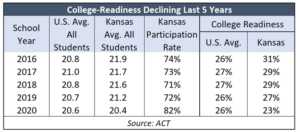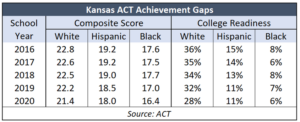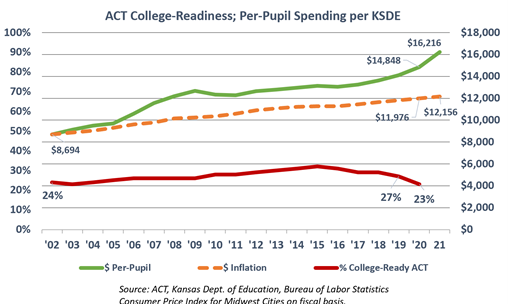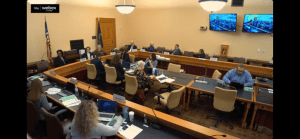The average 2020 ACT score in Kansas declined for the fourth consecutive year, to 20.4, and the decline in college-readiness to 23% marked the fifth consecutive drop. Kansas is now below the national average, which fell from 20.7 to 20.6.
Only 23% of Kansas students did well enough to be considered college-ready in English,  Reading, Math, and Science on the 2020 ACT. That’s down from 27% in 2019 and for the first time, below the national average, which is 26%.
Reading, Math, and Science on the 2020 ACT. That’s down from 27% in 2019 and for the first time, below the national average, which is 26%.
State average scores are skewed by two major factors – demographic differences among the states and participation rates (the percentage of students taking the ACT in each state).
Participation rates affect average state scores because, in states where the ACT isn’t mandatory, only students planning to attend college are likely to take the test, and that will artificially increase average state scores over states where the ACT is mandatory for all students. The Kansas Legislature recently approved paying for students to take the ACT and the state’s participation rate jumped from 72% in 2019 to 82% in 2020. The higher participation rate wiped out some of the state’s artificial advantage and likely contributed to the lower score.
 Large achievement gaps between white students and students of color, and between low-income students and everyone else, also skew state average scores. States with higher portions of minorities and low-income kids will appear to have lower average scores because of achievement differences.
Large achievement gaps between white students and students of color, and between low-income students and everyone else, also skew state average scores. States with higher portions of minorities and low-income kids will appear to have lower average scores because of achievement differences.
ACT doesn’t publish income-based demographics but the achievement gaps in Kansas between White, Hispanic, and Black students are significant and persistent. Only 6% of Black students are college-ready compared to 11% for Hispanic students and 28% for White students.
College-readiness has consistently declined since 2016 for each demographic cohort. White students’ college-readiness fell from 36% to 28%, Hispanic students from 15% to 11%, and Black students dropped from 8% to 6%.
Each demographic cohort’s composite score declined along with the drop in college readiness and is now below 2003 levels.

And while many school officials say more spending is needed to improve achievement, the declines in composite scores and college readiness occurred while spending significantly increased.
Per-student spending increased from $8,694 in 2002 to $14,848 last year and is estimated to exceed $16,000 this year. Spending would have been $11,976 last year If only increased for inflation; that means actual spending was 24% above inflation last year.

House K-12 Budget Chair Kristey Williams, an Augusta Republican, is concerned about the ACT declines and says legislators should be prepared to take action.
“We should continue to monitor student ACT outcomes and identify root causes. I’ll be looking forward to results from our juniors this 2021 semester to help better understand what’s going on in Kansas and how to appropriately respond.”



